Hybrid Artificial Neural Network-Based Models to Investigate Deformation Behavior of AZ31B Magnesium Alloy at Warm Tensile Deformation
Abstract
:1. Introduction
2. Materials and Experimental Procedures
3. Proposed Flow Stress Models for Describing Hot Deformation Behavior
3.1. Development of Artificial Neural Network Model with Backpropagation (BP–ANN) Algorithm
3.2. Development of BP–ANN Model with a Genetic Algorithm
3.3. Development of BP–ANN Model with a Constrained Nonlinear Function
3.4. Model Validation and Verification
4. Results and Discussion
5. Conclusions
- 1.
- Based on the obtained flow stress data, a feed forward back–propagation artificial neural network (BP–ANN) model, a hybrid model with a genetic algorithm (GABP–ANN), and a constrained nonlinear function (CFBP–ANN) were investigated to forecast the AZ31B magnesium alloy deformation behavior.
- 2.
- The predicted data from the simple BP–ANN model demonstrated better agreement against the experimental observations and indicated that it can be devised to precisely predict the flow stress in the 0° and 45° rolling directions; however, in the 90° rolling direction, the proposed model cannot represent the material deformation behavior at tested strain rates. For example, the numerical quantifications such as , 0.9829, and AARE, 4.5192%, from the 90° rolling direction, confirm that the simple BP–ANN model cannot represent the flow behavior accurately.
- 3.
- The GABP-ANN model also demonstrated that the optimized GABP-ANN model cannot represent AZ31B magnesium alloy deformation behavior at the tested strain rates. Moreover, incorporating a genetic algorithm with the BP-ANN model also failed to improvise the model performance and resulted in a high prediction error of 5.9037% for the 90° rolling direction, indicating that the GABP–ANN model lacks the model predictability of the BP–ANN model.
- 4.
- The optimized CFBP–ANN models can track the AZ31B magnesium alloy flow behavior accurately across the investigated deformation temperatures and strain rates. Additionally, the prediction error from the proposed hybrid BP–ANN models also confirms that it could capture AZ31B magnesium alloy flow behavior accurately as the prediction errors fall within the ±5 MPa range.
Author Contributions
Funding
Institutional Review Board Statement
Informed Consent Statement
Data Availability Statement
Acknowledgments
Conflicts of Interest
Abbreviations
| JC | Johnson–Cook |
| ZA | Zerilli–Armstrong |
| BP–ANN | Backpropagation artificial neural network |
| GA | Genetic algorithm |
| FE | Finite element |
| HN | Hidden layer neurons |
| IN | Input layer variables |
| NT | Number of training data |
| NO | Output layer variables |
| IW | Lower bound limit of weights in hidden layer |
| IW | Upper bound limit of weights in hidden layer |
| LW | Lower bound limit of weights in output layer |
| LW | Upper bound limit of weights in output layer |
| b1 | Lower bound limit of biases in hidden layer |
| b1 | Upper bound limit of biases in hidden layer |
| b2 | Lower bound limit of biases in output layer |
| b2 | Upper bound limit of biases in output layer |
| Coefficient of determination | |
| AARE | Average absolute relative error |
| RMSE | Relative mean square error |
References
- Dong, J.R.; Zhang, D.F.; Dong, Y.F.; Pan, F.S.; Chai, S.S. Critical damage value of AZ31B magnesium alloy with different temperatures and strain rates. Rare Metals 2015, 40, 137–142. [Google Scholar] [CrossRef]
- Giorjao, R.A.R.; Monlevade, E.F.; Avila, J.A.; Tschiptschin, A.P. Numerical modeling of flow stress and grain evolution of an Mg AZ31B alloy based on hot compression tests. J. Braz. Soc. Mech. Sci. Eng. 2019, 42, 57. [Google Scholar] [CrossRef]
- Wu, X.T.; Jin, Z.Y.; Liu, J.; Huang, X. Study on Flow Stress Characteristics of AZ31B under Multi-Stage Hot Deformation. Appl. Mech. Mater. 2013, 310, 117–123. [Google Scholar] [CrossRef]
- Liu, J.; Cui, Z.; Li, C. modeling of flow stress characterizing dynamic recrystallization for magnesium alloy AZ31B. Comput. Mater. Sci. 2008, 41, 375–382. [Google Scholar] [CrossRef]
- Takuda, H.; Morishita, T.; Kinoshita, T.; Shirakawa, N. modeling of formula for flow stress of a magnesium alloy AZ31 sheet at elevated temperatures. J. Mater. Process. Technol. 2005, 164–165, 1258–1262. [Google Scholar] [CrossRef]
- Abbasi-Bani, A.; Zarei-Hanzaki, A.; Pishbin, M.; Haghdadi, N. A comparative study on the capability of Johnson–Cook and Arrhenius-type constitutive equations to describe the flow behavior of Mg–6Al–1Zn alloy. Mech. Mater. 2014, 71, 52–61. [Google Scholar] [CrossRef]
- Li, H.Y.; Li, Y.H.; Wang, X.F.; Liu, J.J.; Wu, Y. A comparative study on modified Johnson Cook, modified Zerilli–Armstrong and Arrhenius-type constitutive models to predict the hot deformation behavior in 28CrMnMoV steel. Mater. Des. 2013, 49, 493–501. [Google Scholar] [CrossRef]
- He, A.; Xie, G.; Zhang, H.; Wang, X. A comparative study on Johnson–Cook, modified Johnson–Cook and Arrhenius-type constitutive models to predict the high temperature flow stress in 20CrMo alloy steel. Mater. Des. 2013, 52, 677–685. [Google Scholar] [CrossRef]
- Chen, L.; Zhao, G.; Yu, J. Hot deformation behavior and constitutive modeling of homogenized 6026 aluminum alloy. Mater. Des. 2015, 74, 25–35. [Google Scholar] [CrossRef]
- Zhao, Q.; Yu, L.; Ma, Z.; Li, H.; Wang, Z.; Liu, Y. Hot Deformation Behavior and Microstructure Evolution of 14Cr ODS Steel. Materials 2018, 11, 1044. [Google Scholar] [CrossRef] [Green Version]
- Liu, L.; Wu, Y.; Gong, H.; Li, S.; Ahmad, A.S. A Physically Based Constitutive Model and Continuous Dynamic Recrystallization Behavior Analysis of 2219 Aluminum Alloy during Hot Deformation Process. Materials 2018, 11, 1443. [Google Scholar] [CrossRef] [PubMed] [Green Version]
- Li, J.; Li, F.; Cai, J. Constitutive Model Prediction and Flow Behavior Considering Strain Response in the Thermal Processing for the TA15 Titanium Alloy. Materials 2018, 11, 1985. [Google Scholar] [CrossRef] [PubMed] [Green Version]
- Murugesan, M.; Jung, D. Johnson Cook Material and Failure Model Parameters Estimation of AISI-1045 Medium Carbon Steel for Metal Forming Applications. Materials 2019, 12, 609. [Google Scholar] [CrossRef] [PubMed] [Green Version]
- Liang, Z.; Zhang, Q. Quasi-Static Loading Responses and Constitutive Modeling of Al–Si–Mg alloy. Metals 2018, 8, 838. [Google Scholar] [CrossRef] [Green Version]
- Song, W.; Ning, J.; Mao, X.; Tang, H. A modified Johnson–Cook model for titanium matrix composites reinforced with titanium carbide particles at elevated temperatures. Mater. Sci. Eng. A 2013, 576, 280–289. [Google Scholar] [CrossRef]
- Li, H.; Wang, X.; Duan, J.; Liu, J. A modified Johnson Cook model for elevated temperature flow behavior of T24 steel. Mater. Sci. Eng. A 2013, 577, 138–146. [Google Scholar] [CrossRef]
- Wang, X.; Huang, C.; Zou, B.; Liu, H.; Zhu, H.; Wang, J. Dynamic behavior and a modified Johnson–Cook constitutive model of Inconel 718 at high strain rate and elevated temperature. Mater. Sci. Eng. A 2013, 580, 385–390. [Google Scholar] [CrossRef]
- Tan, J.Q.; Zhan, M.; Liu, S.; Huang, T.; Guo, J.; Yang, H. A modified Johnson–Cook model for tensile flow behaviors of 7050-T7451 aluminum alloy at high strain rates. Mater. Sci. Eng. A 2015, 631, 214–219. [Google Scholar] [CrossRef]
- Murugesan, M.; Jung, D.W. Two flow stress models for describing hot deformation behavior of AISI-1045 medium carbon steel at elevated temperatures. Heliyon 2019, 5, e01347. [Google Scholar] [CrossRef] [PubMed] [Green Version]
- Lin, Y.; Chen, X.M. A combined Johnson–Cook and Zerilli–Armstrong model for hot compressed typical high-strength alloy steel. Comput. Mater. Sci. 2010, 49, 628–633. [Google Scholar] [CrossRef]
- Zhan, H.; Wang, G.; Kent, D.; Dargusch, M. Constitutive modeling of the flow behaviour of a β titanium alloy at high strain rates and elevated temperatures using the Johnson–Cook and modified Zerilli–Armstrong models. Mater. Sci. Eng. A 2014, 612, 71–79. [Google Scholar] [CrossRef] [Green Version]
- He, A.; Wang, X.-t.; Xie, G.-l.; Yang, X.-y.; Zhang, H.-l. Modified arrhenius-type constitutive model and artificial neural network-based model for constitutive relationship of 316LN stainless steel during hot deformation. J. Iron Steel Res. Int. 2015, 22, 721–729. [Google Scholar] [CrossRef]
- Han, Y.; Qiao, G.; Sun, J.; Zou, D. A comparative study on constitutive relationship of as-cast 904L austenitic stainless steel during hot deformation based on Arrhenius-type and artificial neural network models. Comput. Mater. Sci. 2013, 67, 93–103. [Google Scholar] [CrossRef]
- Senthilkumar, V.; Balaji, A.; Arulkirubakaran, D. Application of constitutive and neural network models for prediction of high temperature flow behavior of Al/Mg based nanocomposite. Trans. Nonferrous Met. Soc. China 2013, 23, 1737–1750. [Google Scholar] [CrossRef]
- Murugesan, M.; Sajjad, M.; Jung, D.W. Microstructure Evaluation and Constitutive Modeling of AISI-1045 Steel for Flow Stress Prediction under Hot Working Conditions. Symmetry 2020, 12, 782. [Google Scholar] [CrossRef]
- Xiao, X.; Liu, G.; Hu, B.; Zheng, X.; Wang, L.; Chen, S.; Ullah, A. A comparative study on Arrhenius-type constitutive equations and artificial neural network model to predict high-temperature deformation behaviour in 12Cr3WV steel. Comput. Mater. Sci. 2012, 62, 227–234. [Google Scholar] [CrossRef]
- Li, H.Y.; Wei, D.D.; Li, Y.H.; Wang, X.F. Application of artificial neural network and constitutive equations to describe the hot compressive behavior of 28CrMnMoV steel. Mater. Des. 2012, 35, 557–562. [Google Scholar] [CrossRef]
- Stendal, J.; Bambach, M.; Eisentraut, M.; Sizova, I.; Weiß, S. Applying Machine Learning to the Phenomenological Flow Stress Modeling of TNM-B1. Metals 2019, 9, 220. [Google Scholar] [CrossRef] [Green Version]
- Wu, S.; Zhou, X.; Chen, Q.; Ren, J.; Cao, G.; Liu, Z. Development of Constitutive Models for Extrapolative Prediction of Nb-Ti Micro Alloyed Steel. Steel Res. Int. 2017, 88, 1700082. [Google Scholar] [CrossRef]
- Thakur, S.K.; Das, A.K.; Jha, B.K. Development of an Integrated Flow Stress and Roll Force Models for Plate Rolling of Microalloyed Steel. Steel Res. Int. 2021, 93, 2100479. [Google Scholar] [CrossRef]
- Murugesan, M.; Sajjad, M.; Jung, D.W. Hybrid Machine Learning Optimization Approach to Predict Hot Deformation Behavior of Medium Carbon Steel Material. Metals 2019, 9, 1315. [Google Scholar] [CrossRef] [Green Version]
- Murugesan, M.; Yu, J.H.; Chung, W.; Lee, C.W. Warm Deformation Behavior and Flow Stress Modeling of AZ31B Magnesium Alloy under Tensile Deformation. Materials 2023, 16, 5088. [Google Scholar] [CrossRef]
- Murugesan, M.; Yu, J.H.; Jung, K.S.; Cho, S.M.; Bhandari, K.S.; Chung, W.; Lee, C.W. Supervised Machine Learning Approach for Modeling Hot Deformation Behavior of Medium Carbon Steel. Steel Res. Int. 2022, 94, 2200188. [Google Scholar] [CrossRef]
- Bong, H.J.; Lee, J.; Lee, M.G. Modeling crystal plasticity with an enhanced twinning–detwinning model to simulate cyclic behavior of AZ31B magnesium alloy at various temperatures. Int. J. Plast. 2022, 150, 103190. [Google Scholar] [CrossRef]
- Ashtiani, H.R.; Shahsavari, P. A comparative study on the phenomenological and artificial neural network models to predict hot deformation behavior of AlCuMgPb alloy. J. Alloys Compd. 2016, 687, 263–273. [Google Scholar] [CrossRef]
- Carpenter, W.C.; Barthelemy, J.F. Common Misconceptions about Neural Networks as Approximators. J. Comput. Civ. Eng. 1994, 8, 345–358. [Google Scholar] [CrossRef]
- Oreta, A.W.C.; Kawashima, K. Neural Network Modeling of Confined Compressive Strength and Strain of Circular Concrete Columns. J. Struct. Eng. 2003, 129, 554–561. [Google Scholar] [CrossRef]
- Chen, W.; Li, S.; Bhandari, K.S.; Aziz, S.; Chen, X.; Jung, D.W. Genetic optimized Al–Mg alloy constitutive modeling and activation energy analysis. Int. J. Mech. Sci. 2023, 244, 108077. [Google Scholar] [CrossRef]
- Murugesan, M.; Kang, B.S.; Lee, K. Multi-Objective Design Optimization of Composite Stiffened Panel Using Response Surface Methodology. J. Compos. Res. 2015, 28, 297–310. [Google Scholar] [CrossRef] [Green Version]
- Lee, K.; Murugesan, M.; Lee, S.M.; Kang, B.S. A Comparative Study on Arrhenius-Type Constitutive Models with Regression Methods. Trans. Mater. Process. 2017, 26, 18–27. [Google Scholar] [CrossRef] [Green Version]

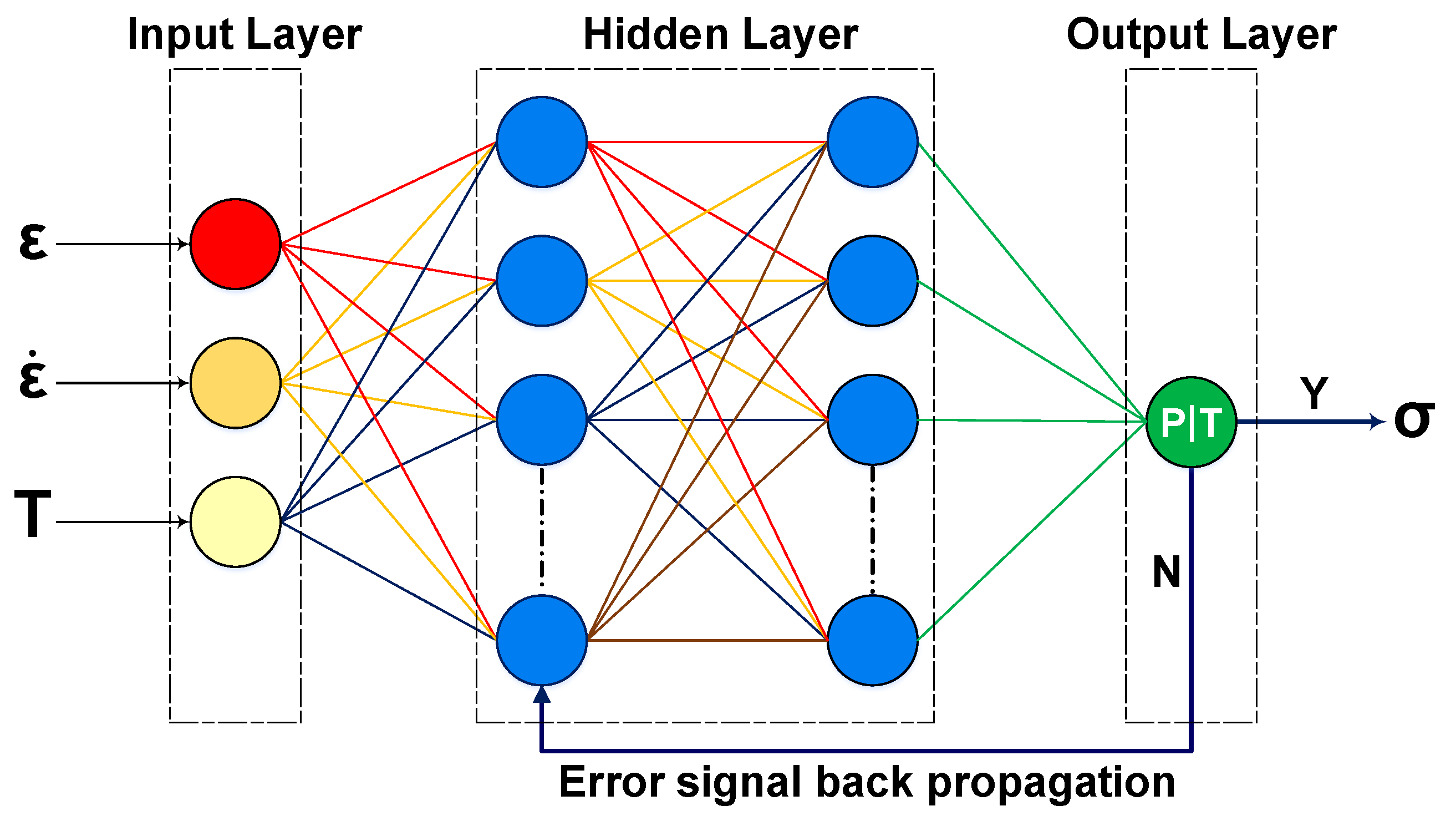
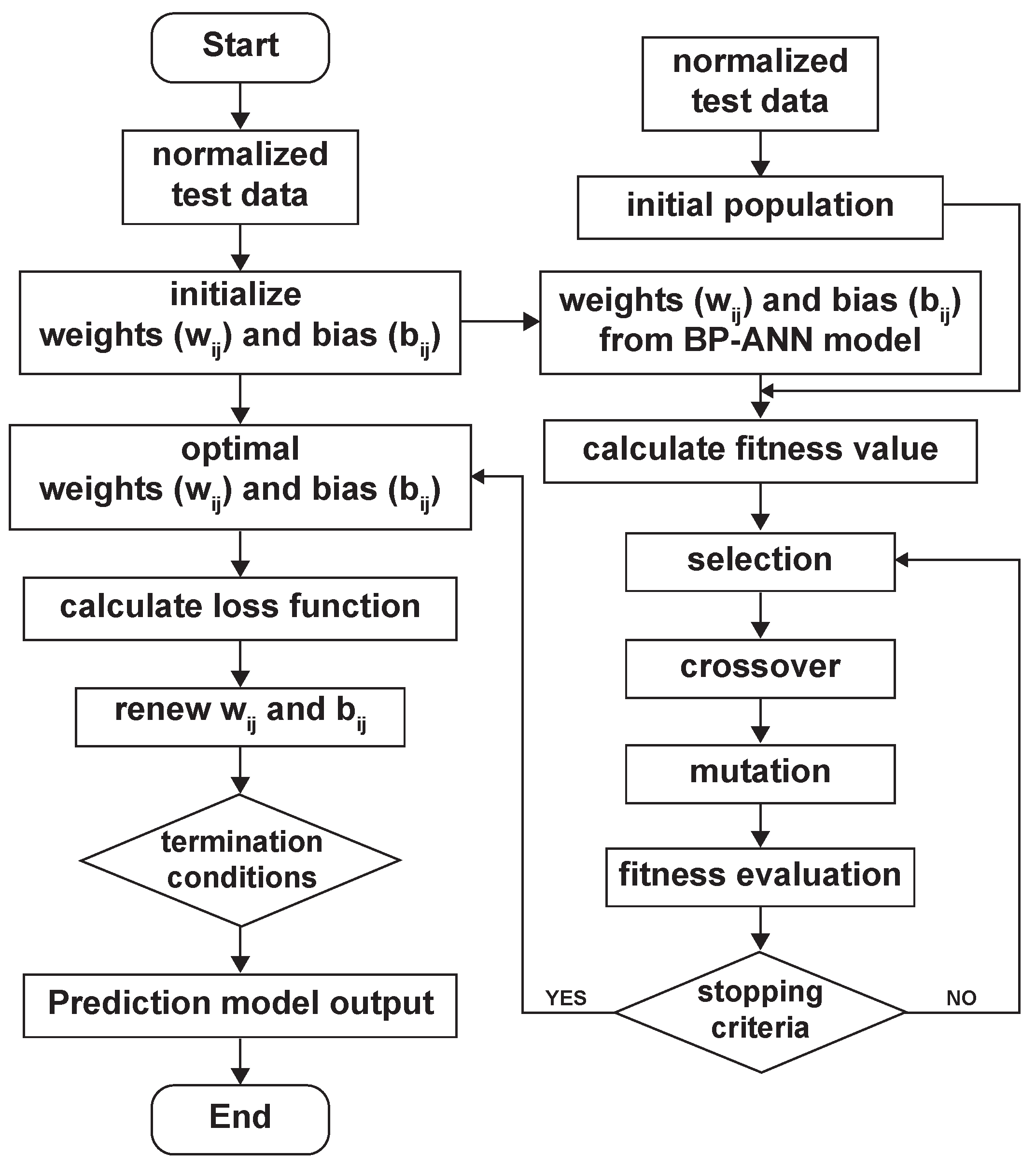
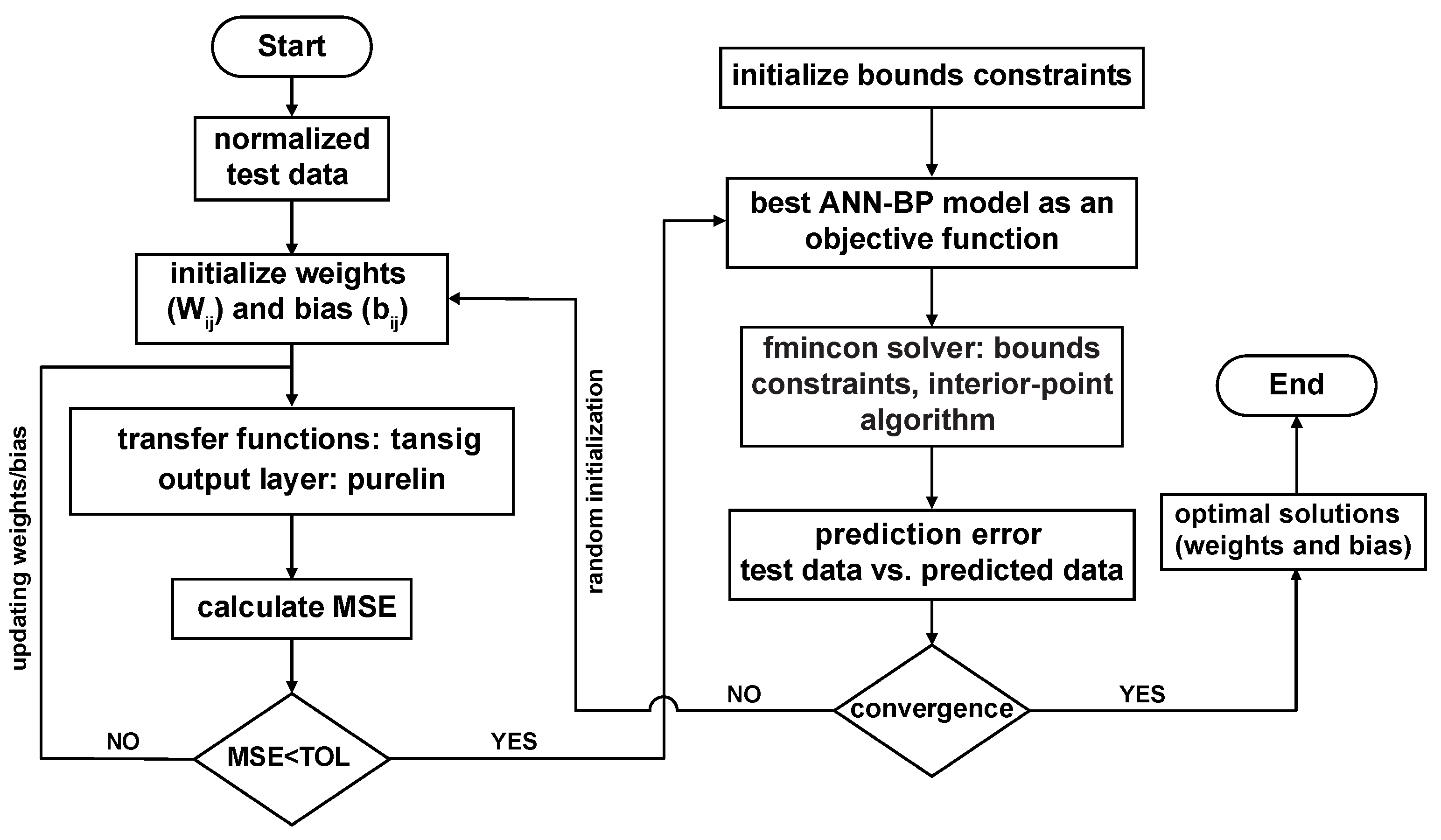
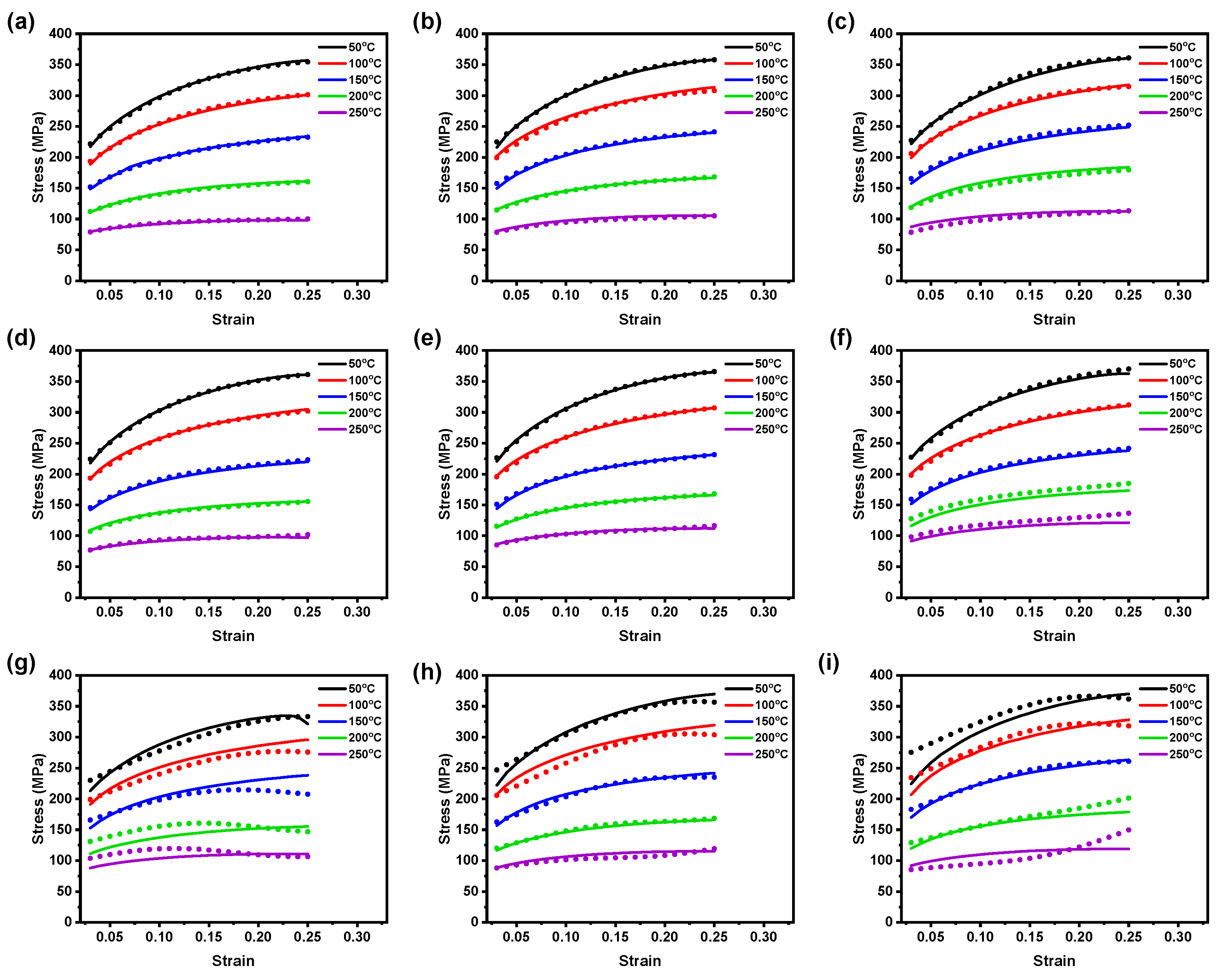


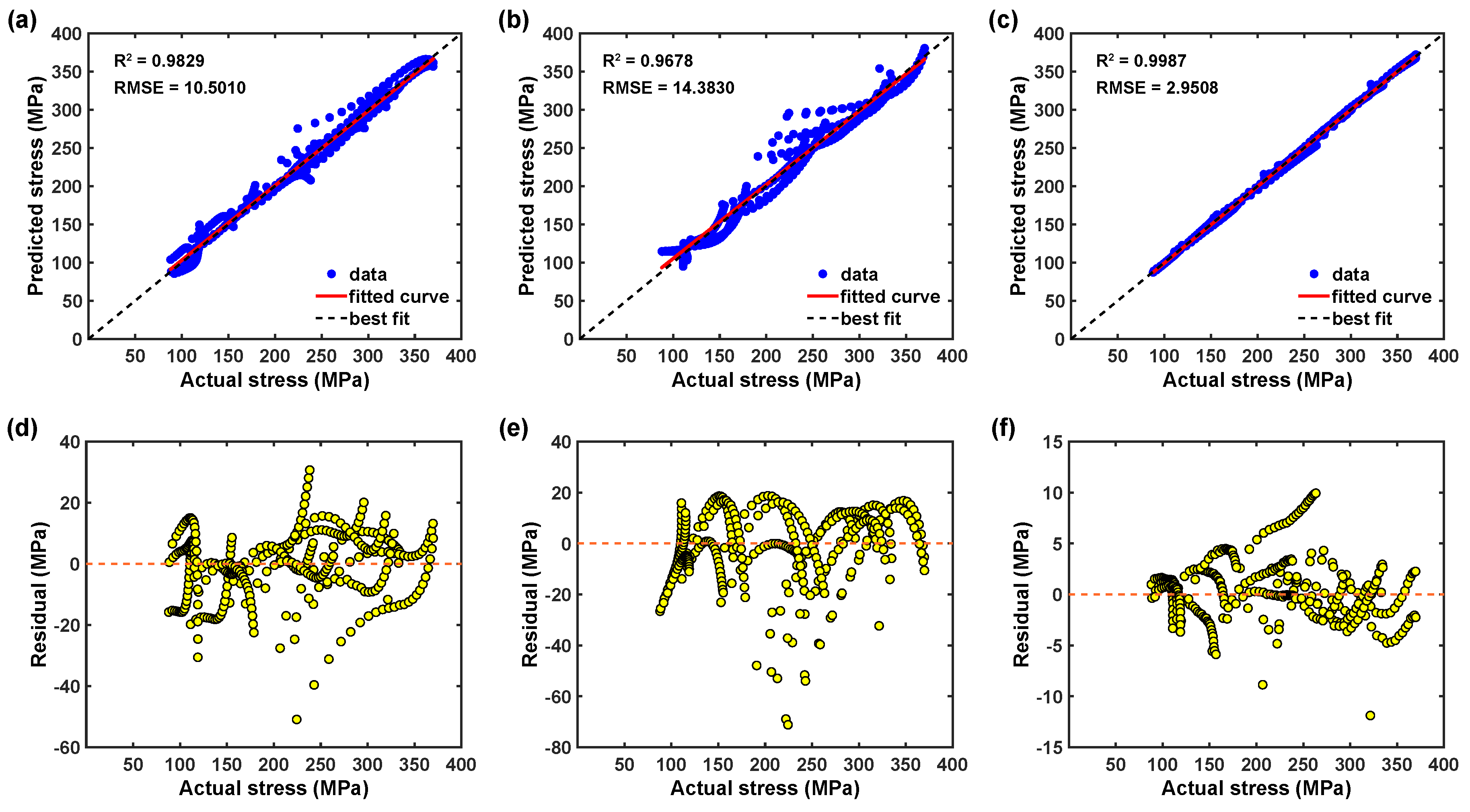


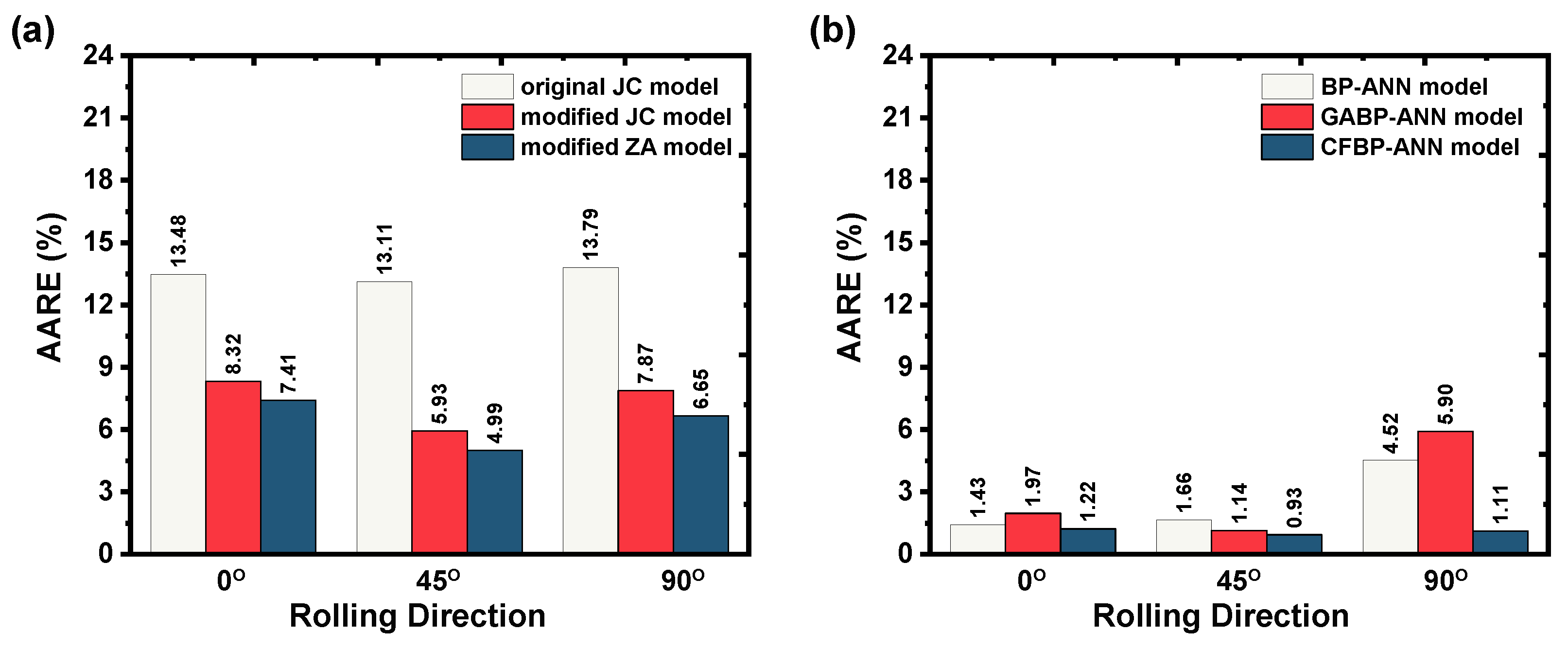
| Mg | Al | Zn | Mn | Si | Cu | Ca | Fe | Ni |
|---|---|---|---|---|---|---|---|---|
| Balance | 2.50–3.50 | 0.60–1.40 | 0.20 | 0.10 | 0.05 | 0.04 | 0.005 | 0.005 |
| Angle | Conditions | BP–ANN Model | GABP–ANN Model | CFBP–ANN Model | |||
|---|---|---|---|---|---|---|---|
| Overall– | Overall– | Overall– | |||||
| 0° | 0.005 s | 0.9996 | 0.9988 | 0.9978 | 0.9973 | 0.9996 | 0.9990 |
| 0.01 s | 0.9991 | 0.9972 | 0.9991 | ||||
| 0.0167 s | 0.9984 | 0.9970 | 0.9982 | ||||
| 45° | 0.005 s | 0.9995 | 0.9983 | 0.9993 | 0.9991 | 0.9998 | 0.9993 |
| 0.01 s | 0.9996 | 0.9991 | 0.9998 | ||||
| 0.0167 s | 0.9981 | 0.9991 | 0.9989 | ||||
| 90° | 0.005 s | 0.9836 | 0.9829 | 0.9710 | 0.9678 | 0.9990 | 0.9987 |
| 0.01 s | 0.9954 | 0.9696 | 0.9996 | ||||
| 0.0167 s | 0.9841 | 0.9664 | 0.9978 | ||||
| Angle | AARE (%) | ||
|---|---|---|---|
| BP–ANN Model | GABP–ANN Model | CFBP–ANN Model | |
| 0° | 1.4269 | 1.9657 | 1.2172 |
| 45° | 1.6587 | 1.1377 | 0.9327 |
| 90° | 4.5192 | 5.9037 | 1.1081 |
Disclaimer/Publisher’s Note: The statements, opinions and data contained in all publications are solely those of the individual author(s) and contributor(s) and not of MDPI and/or the editor(s). MDPI and/or the editor(s) disclaim responsibility for any injury to people or property resulting from any ideas, methods, instructions or products referred to in the content. |
© 2023 by the authors. Licensee MDPI, Basel, Switzerland. This article is an open access article distributed under the terms and conditions of the Creative Commons Attribution (CC BY) license (https://creativecommons.org/licenses/by/4.0/).
Share and Cite
Murugesan, M.; Yu, J.-H.; Chung, W.; Lee, C.-W. Hybrid Artificial Neural Network-Based Models to Investigate Deformation Behavior of AZ31B Magnesium Alloy at Warm Tensile Deformation. Materials 2023, 16, 5308. https://doi.org/10.3390/ma16155308
Murugesan M, Yu J-H, Chung W, Lee C-W. Hybrid Artificial Neural Network-Based Models to Investigate Deformation Behavior of AZ31B Magnesium Alloy at Warm Tensile Deformation. Materials. 2023; 16(15):5308. https://doi.org/10.3390/ma16155308
Chicago/Turabian StyleMurugesan, Mohanraj, Jae-Hyeong Yu, Wanjin Chung, and Chang-Whan Lee. 2023. "Hybrid Artificial Neural Network-Based Models to Investigate Deformation Behavior of AZ31B Magnesium Alloy at Warm Tensile Deformation" Materials 16, no. 15: 5308. https://doi.org/10.3390/ma16155308





